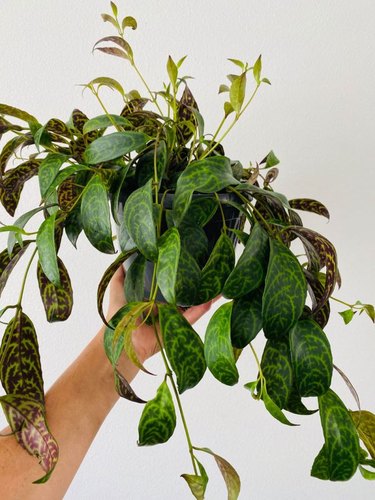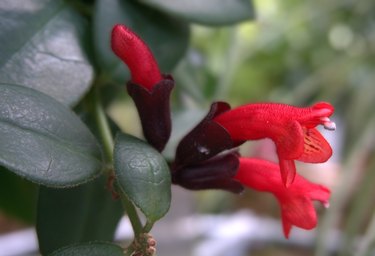
The "lipstick plant" is building a loyal, almost cultish, following these days, and I've jumped on the bandwagon. I must admit that its common name put me off a little, but when I saw one for the bloom for the first time, I found that it was an absolute showstopper! The lipstick plant hails from the tropics of Asia, and it is guaranteed to turn heads with its cascading leafy vines tipped by vibrant red, tubular flowers that really do look like little tubes of lipstick.
Commonly growing in a cascading pattern with stems 2 to 3 feet long, a lipstick houseplant rocks a hanging basket. It has only a few "musts" on its care list, so even a beginner can succeed with this standout houseplant. Treat it right and you can delight in an amazing display for much of the year.
Video of the Day
Video of the Day
Lipstick Plant Highlights
Botanical name: Aeschynanthus spp.
Easy Care?: Yes!
Light + Location: Bright indirect light
Watering: Water regularly to keep soil evenly moist, but avoid over-watering
Growth Rate: Fast-growing
Flowering: Red, pink, or orange blossoms for several months or more, depending on species
Pet-Safe?: Yes! Non-toxic to dogs, cats, and horses.
All About the Lipstick Plant
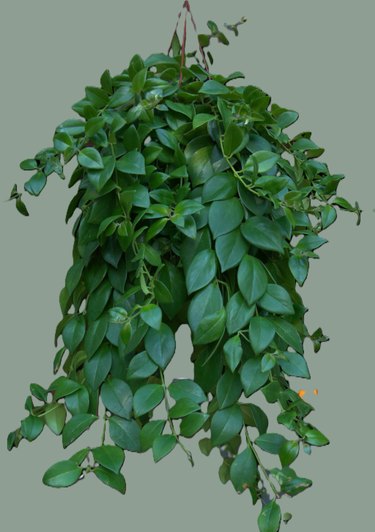
When it comes to houseplants, I tend to prefer foliage to flowers, but don't make the mistake I did and think you have to pick one or the other. A lipstick plant's shiny, bright-green, waxy leaves grow thick on vine-like stems that tumble out of a container in graceful waves. (Think pothos plants with smaller leaves but twice as many of them.) When the purple buds appear and then bloom, it feels like the plant has burst into song.
Despite the common name, the brilliant blossoms of the lipstick plant are NOT used in the manufacture of lip products of any kind. In fact, Aeschynanthus plants are native to tropical Asia where they grow in tree branches or cracks in rocks as air plants, getting their nutrients from the air. That means lipstick plants are hardy outdoors only in the warmest zones, like USDA hardiness zones 10 and 11. But they adjust well to ordinary household temperatures and grow happily as long as their cultural needs are met.
Types of Lipstick Plants
Don't be surprised to find any of a number of Aeschynanthus species at the garden store. All of them have the same vining growth habit and bright, lipstick-shaped flowers, but they do have differences. For example, some have variegated or twisted leaves, and the flower colors vary.
Perhaps most important when choosing a cultivar is the bloom period. While some types of lipstick plant bloom in spring, summer, and fall, others bloom only in fall and winter. But again, even without flowers, these are all stunners.
Lipstick Plant (Aeschynanthus radicans)
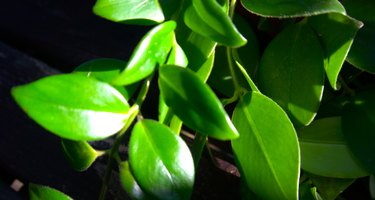
This is the "standard" lipstick plant variety that you are most likely to find in garden stores, with solid green leaves and showy red flowers. They may bloom year-round with proper care. But, look out! Several varieties are offered under this same botanical name, including:
- Curly lipstick plant (sometimes called 'Curly') with wavy leaves
- 'Variegata' cultivar with yellow and white splotches on the leaves
- Purple Star lipstick plant, with pink and deep purple blooms that appear only in fall and winter
Mona Lisa Lipstick Plant (Aeschynanthus lobbianus, aka Aeschynanthus radicans 'Mona Lisa' )
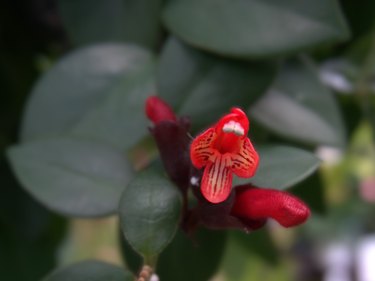
Mona Lisa's bright red and/or hot pink blossoms emerge from gorgeous hanging foliage in fall and winter. Their simple shape and bright shades are eye-catching and make you think of a watercolor painting.
Black Pagoda Lipstick Plant (Aeschynanthus longicaulis)
Here's another stunning choice. The leaves are exceptionally long for a lipstick plant — up to 5 inches. They are forest green with an unusual iridescent sheen and silvery patterning that contrasts beautifully with the purple underside of the leaves. The blossoms are salmon pink, flowering in late winter.
Care and Feeding of a Lipstick Plant
Even after all the years I've spent tending and writing about houseplants, I still have some trouble assigning them a place on the scale between easy-care and difficult-to-grow. Clearly, classics like spider plants and pothos seem to be indestructible and will shrug off human negligence time after time. On the far side are hot house tropicals that need precise cultural care including a humidity level impossible to maintain outside of a green house.
The lipstick plant is easy to care for, if not quite as easy as indestructible specimens like spider plants or pothos. If you don't provide your lipstick plant with appropriate light and soil, it will throw a fit, wilt, and likely die. Yet, because it's needs are so easy to meet, I still classify it as a good beginner plant. Maybe not one to give your teen to take to a college dorm, but certainly a plant any plant lover can maintain with ease.
Here's what your lipstick plant needs most:
- A bright location out of direct sun
- A container with good drain holes
- Light potting soil that drains well
- Regular — but moderate — amounts of water
Let's talk a bit more about each of these requirements.
Best Location for Lipstick Plant
A happy balance of light is essential for lipstick plants. Place your plant in a spot that gets lots of bright, indirect sunlight. Direct sun will wilt the foliage and ultimately kill the plant. On the other hand, if a lipstick plant doesn't get enough sun, you will see fewer flowers, or maybe even none.
Potting Soil for Lipstick Plant
Remember that the lipstick plant in the wild is an air plant and doesn't have a need for soil. It gets its nutrients directly from the air and rainfall. So when potting at home, keep the potting soil light and well-drained. It's ideal to mix sand or sphagnum moss into the soil to keep it loose and airy.
Air Temperature and Humidity for Lipstick Plant
Although these plants thrive outdoors only in the warmest zones, they are content to be indoor plants in most houses. Consistent temperatures of 60°F to 70°F will keep your lipstick plant happy.
Regarding humidity, the more the better. If you have a small humidifier, position it near the houseplant. Alternatively, mist in the morning.
Watering Your Lipstick Plant
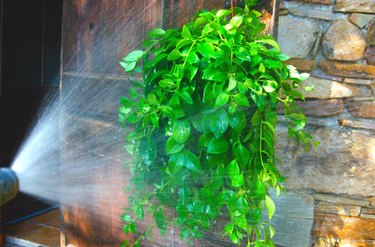
This plant likes water, but not too much at any one time. Provide regular water to keep the soil moist but not wet. Poke a finger into the soil every day or two, and water when it feels dry. Be sure the container has lots of drain holes. It's also fun to give your plant a hose shower from time to time.
Best Fertilizer for Lipstick Plant
I'm not a fan of fertilizer for houseplants, but with the lipstick plant, it's important. This is a plant that likes its nutrients, so feed it monthly during the growing season with a half-strength dose of water-soluble fertilizer.
Propagating the Lipstick Plant
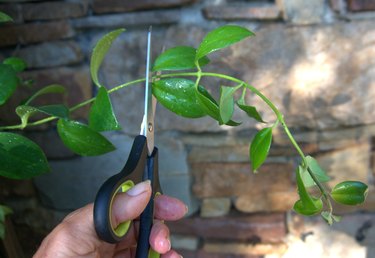
Propagating a lipstick plant is easy, so if you love your first plant, make a few more with cuttings. Clip off a healthy stem — without blossums — about 6 inches long, then remove most of the lower leaves. Root it in water or light soil. Roots should appear in less than a month, then it's time to transplant it into its own container.
Tip
Can you grow a lipstick plant from flower seeds? Yes you can. Plant them shallowly in well-draining soil. They should germinate in a few weeks.
Repotting Your Lipstick Plant
A lipstick plant grows fast and eventually needs a larger container. Signs that it's time to repot include slowing growth or roots peeking out of the container's drain hole.
Coax the rootball out of the pot to see if its rootbound. If you see mostly roots in the container, repot the plant in a slightly larger container (at least 2 inches larger in diameter than the original) in early spring. Untangle the roots and snip off dead roots with sterile scissors or pruning shears. Use fresh, well-aerated soil to fill in the bottom and sides of the new pot. Water well after repotting.
Lipstick Plant FAQs

Why isn't my lipstick plant flowering?
A lipstick plant failing to flower is typically caused by inadequate sunlight. Be sure it's in a bright spot where it gets good amounts if indirect sun. It's also possible that it simply isn't time for your plant to bloom. Some lipstick plant varieties bloom in spring and summer, others bloom most of the year, and still others bloom only in fall and winter.
Why is my lipstick plant foliage is turning yellow?
Yellow leaves on a lipstick plant generally indicate poor cultural care. Make sure the plant is getting adequate (but indirect) sunlight, and be vigilant about checking the soil regularly and watering.
Do lipstick plant flowers smell sweet?
This is a tough one, since the flowers are so vibrant and bright it seems they should smell delightful. But, no, the flowers have no fragrance at all.
How do I prune a lipstick plant?
If the trailing vines are just too long, pruning is entirely possible. You can trim off a third of each stem without weakening the plant. The best time to do this is when the plant finishes blooming. Make some friends happy by rooting the stem cuttings as gifts.
